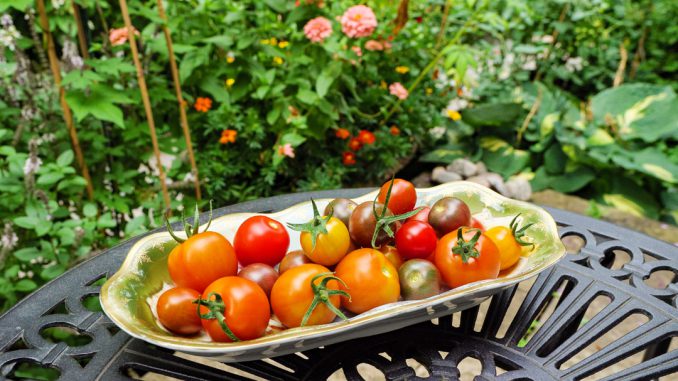
Returning to a Canadian spring, this could be the year of your best tomato success. And, with a new perspective on lawn care, you can beat the heat in mid-summer.
Timing is everything
Without doubt, the most delicious tomato is the one that you grow yourself. Carefully watched for the peak day of ripeness and sliced thickly for the first tomato sandwich of summer, it’s the gratification of a gardener’s most heartfelt effort.
Tomato plants have abundant vigour and will grow in any good garden soil or container with sufficient moisture and a minimum of four hours of direct sun each day. Young tomato plants resent chilly air and, in northern climates, can’t be set out until overnight temperatures are higher than 10 degrees Celsius (50 degrees Fahrenheit). This temperature requirement often delays planting until the last week of May or the first week of June. The first ripe tomatoes may not be ready for picking until late summer and into early autumn, and that production schedule isn’t the most convenient for travellers preparing for departure. Just when you’re trying to clean and close down the garden, the tomato plants are beginning to put out their best fruits and they’ll keep producing right up to frost. The timing isn’t a comfortable fit with a travelling schedule.
That problem is solved by understanding the two basic tomato categories. Tomato plants that grow and produce flowers until stopped by autumn frost are classified as indeterminate. They have a tall vine structure with foliage spaced out along extending vines that will require staking. Indeterminate vines will continue producing flowers and fruits until they encounter freezing temperatures.
However, tomatoes with a controlled and predictable growth are classified as determinate and make strong, compact bush-form plants, growing to a height of three to four feet. Determinate plants produce all of their tomatoes within a period of three weeks and then stop flowering. This allows for an expectation of tomatoes to be ripening in the mid to late summer, and to finishing flowering by the end of August. And that would be a much better schedule, allowing travellers to enjoy those tomatoes before preparing to take off for winter expeditions.
If you’re shopping for determinate tomato plants this spring, try a garden centre with a large tomato plant section. (Number of days indicates time from setting outside to first ripening fruits.) Determinate, plum-shaped tomatoes with the shortest growth cycle include ‘Pony Express’ (62 days), ‘Roma Supremo’ (65 to 68 days) and ‘Plum Regal’ (75 days). Early-producing determinate plants with round fruits are ‘Polbig’ (55-60 days) and ‘Mountain Spring’ (68 days). Main-season determinates include ‘Mountain Merit’ (72 days), ‘Celebrity’ (70 days) and ‘Skyway’ (72 days). Patio cherry tomatoes suitable for containers are ‘Little Bing’ (red cherries, 60 days) and ‘Little Napoli’ (red plum-shaped, 60 days); both grow to 60 cm (two feet) tall and are charmingly ornamental.
With the right timing – and determinate plants – there’s every expectation of enjoying a luscious homegrown tomato sandwich this summer!
How to drought-proof a lawn
Most conscientious gardeners share a memory of puzzling over a patchy, drought-stricken, browned-out lawn and thinking – how did this happen? Heroic gestures such as running the sprinkler all night won’t reverse these damaged conditions caused by prolonged summer heat and water scarcity. It’s smarter to drought-proof the lawn beginning in spring, in advance of mid-summer heat and moisture stress; and that’s something which you can do right now.
Strengthening the lawn makes it more resilient under stress conditions. Manicured front lawns, neglected boulevard strips and rough cottage grass patches will all benefit from any and all of these practices:
Mow the lawn less frequently, about every 10 days, and keep blade height high. Tall grass blades shade the soil and help to keep heat out of the root zone. Allow cut blades to remain on the lawn as a natural mulch, preventing direct sunlight from reaching the soil.
Reduce nitrogen fertilizer. Too much nitrogen encourages thatch growth, which can prevent moisture from penetrating the soil to the roots. Fertilizer products have three numbers on the package, indicating their nutrient analysis. The first number is nitrogen. Find a fertilizer with a first number no greater than 20. Never fertilize during high heat and drought; instead, wait for cooler weather with normal rain patterns.
Water deeply when direct sunlight is off of the lawn. Avoid oscillator devices that hurl droplets high in the air and lose much water to evaporation. Use a sprinkler that broadcasts large drops of water in a low arc.
Over-seed in the spring and early autumn with drought-resistant grasses such as perennial rye grass and fescue. Cover seeded areas with peat moss or top soil and sprinkle with water every day. Include white clover seed (Trifolium repens, sold in the grass seed section of garden centres, or from online seed sources) to produce a green leaf that won’t brown out under stress. Clover will also contribute nitrogen into the soil.
Core aerate lawns in the autumn or spring to improve drainage and introduce more oxygen into the root zone.


